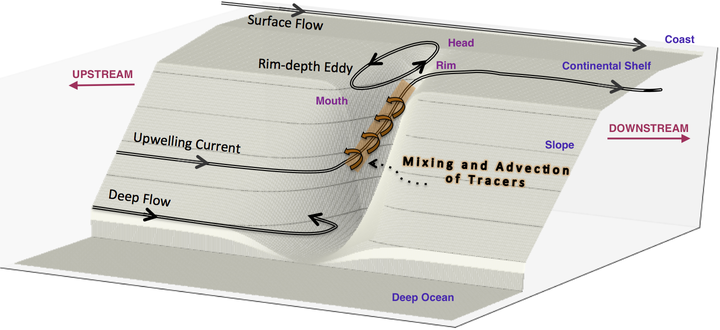Transport through a submarine canyon
 Flow structure during an upwelling event in a short, coastal submarine canyon.
Flow structure during an upwelling event in a short, coastal submarine canyon.
Submarine canyons incise continental shelves all over the world. They are hot spots of biodiversity mainly because they act as conduits for biologically relevant tracers (such as nitrate, phosphate, etc.) by enhancing upwelling. I am studying the impact that submarine canyons have on the amount of tracers that is exchanged between the shelf and the deep ocean, and the spatial and temporal distribution of the upwelled tracer on the shelf. I use an idealized canyon bathymetry and the MIT general circulation model (MITgcm) to develop a scaling scheme for tracer transport onto the shelf given the incomming flow, geometric and geographic parameters of the canyon, tracer profile, and vertical diffusivity and viscosity within the canyon.
Relevant publications
-
Saldías, G. S., Ramos-Musalem, K., & Allen, S. E. (2021). Circulation and upwelling induced by coastal trapped waves over a submarine canyon in an idealized eastern boundary margin. Geophysical Research Letters, 48, e2021GL093548. https://doi.org/10.1029/2021GL093548
-
Ramos‐Musalem, K., & Allen, S. E. (2020). The Impact of Initial Tracer Profile on the Exchange and On‐Shelf Distribution of Tracers Induced by a Submarine Canyon. Journal of Geophysical Research: Oceans, 125(3), e2019JC015785. https://doi.org/10.1029/2019JC015785
-
Ramos-Musalem, K., & Allen, S. E. (2019). The Impact of Locally Enhanced Vertical Diffusivity on the Cross-Shelf Transport of Tracers Induced by a Submarine Canyon. Journal of Physical Oceanography, 49(2), 561-584. https://doi.org/10.1175/JPO-D-18-0174.1